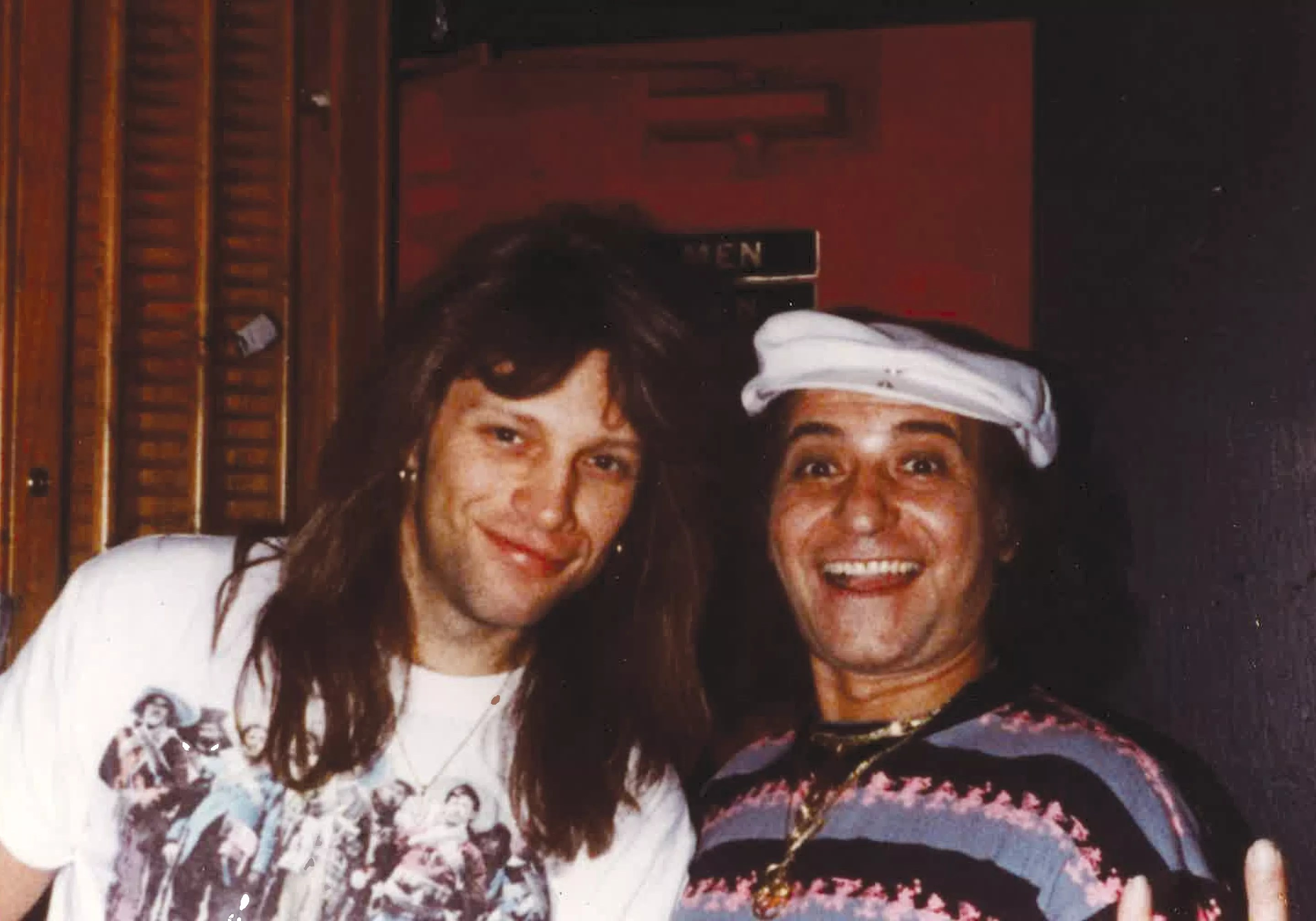
Provided by Franco Gagliano

Audio By Carbonatix
Franco Gagliano’s cluttered home office serves as a veritable shrine to the Phoenix music scene of the ’80s and ’90s. By the looks of things, the rock gods favor total chaos.
Spectacularly strewn around the office are the museum-grade ephemeral remains of the Mason Jar, the hallowed rock club Gagliano owned for decades. Right now, he’s granting Phoenix New Times a glimpse of the inner sanctum of his central Phoenix condo.
“So this is the castle,” Gagliano says in a thick Sicilian accent while making a sweeping gesture with his arm. “You look lost already.”
Lost in Phoenix rock history, perhaps. Crammed in the closet are stacks of lidded boxes packed with old show fliers, band promo photos and newspaper ads. In a corner, an armchair holds piles of monthly planners and legal pads scrawled with Mason Jar gigs dating back 40 years. On the other side of the room a filing cabinet containing old contracts is topped by a pair of cowboy boots abandoned at the club by Alice Cooper.
Will you step up to support New Times this year?
At New Times, we’re small and scrappy — and we make the most of every dollar from our supporters. Right now, we’re $15,500 away from reaching our December 31 goal of $30,000. If you’ve ever learned something new, stayed informed, or felt more connected because of New Times, now’s the time to give back.
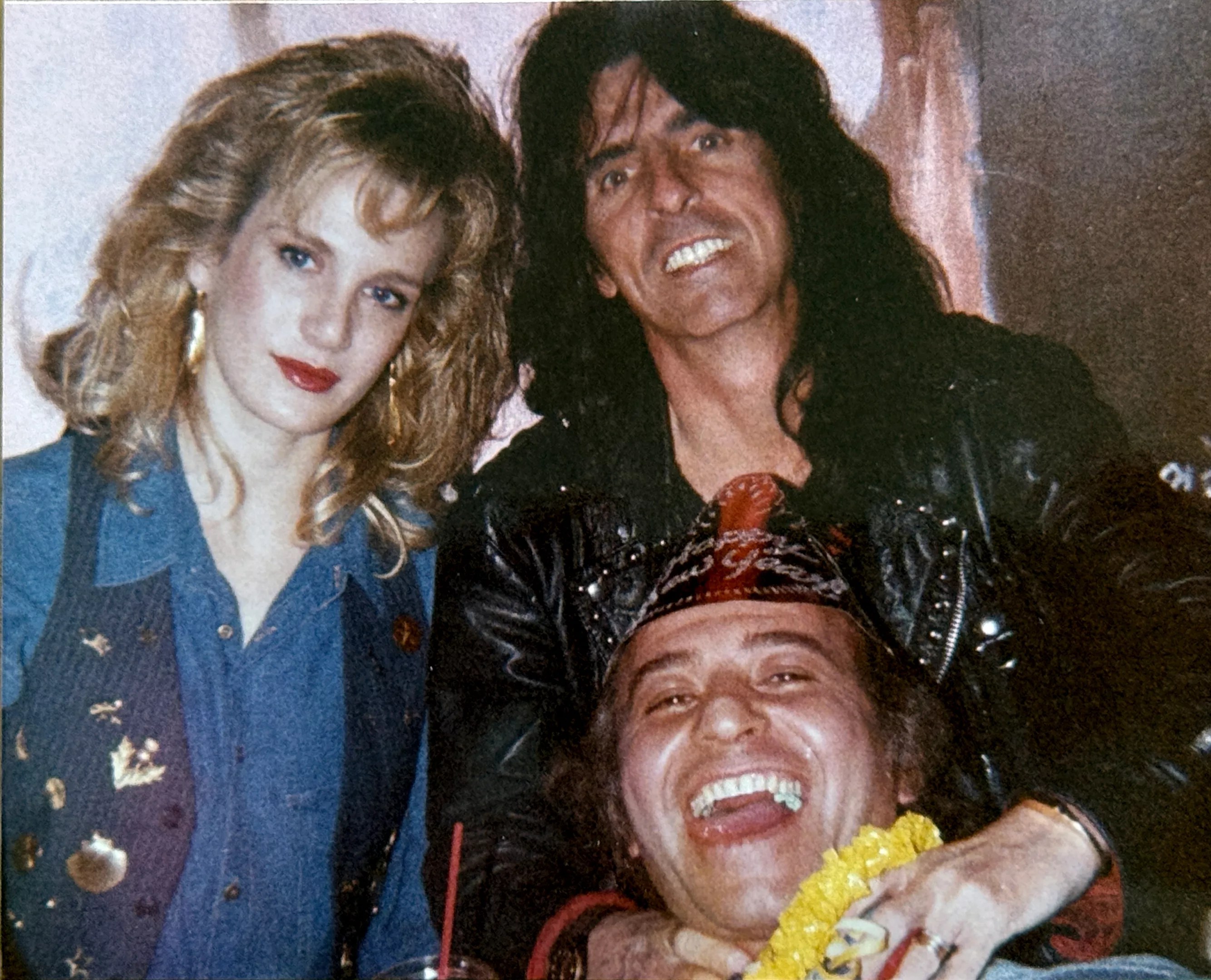
An undated photo of Alice Cooper and Mason Jar owner Franco Gagliano.
Provided by Franco Gagliano
More of Gagliano’s treasures line the walls: a collection of colorful backstage passes. Autographed gold records – like the Gin Blossoms’ 1992 quadruple-platinum album “New Miserable Experience.” Most prominently, a grid of framed snapshots of Gagliano at the Jar alongside rockers local and legendary, including Jon Bon Jovi, Rob Halford and Jason Newsted before he left Phoenix to join Metallica.
Similar photos and records hung on the walls of the club, back in the day. Given the Mason Jar’s status, Gagliano has earned the right to boast. During its 26-year run, the club had other owners. But he remains its most iconic figure, as famous for miserly payouts to local bands as he was for gleefully serving 75-cent kamikazes.
Opened in 1979 as the Mason Jar Lounge, a neighborhood bar on Indian School Road and 23rd Street that offered “excitable rock,” the venue became world-renowned soon after Gagliano took over in the early ’80s. As onetime New Times writer and Gentlemen Afterdark vocalist Brian Smith put it, the Jar was “a great rock ‘n’ roll venue in the tradition of Max’s Kansas City, the Troubadour or CBGB.”
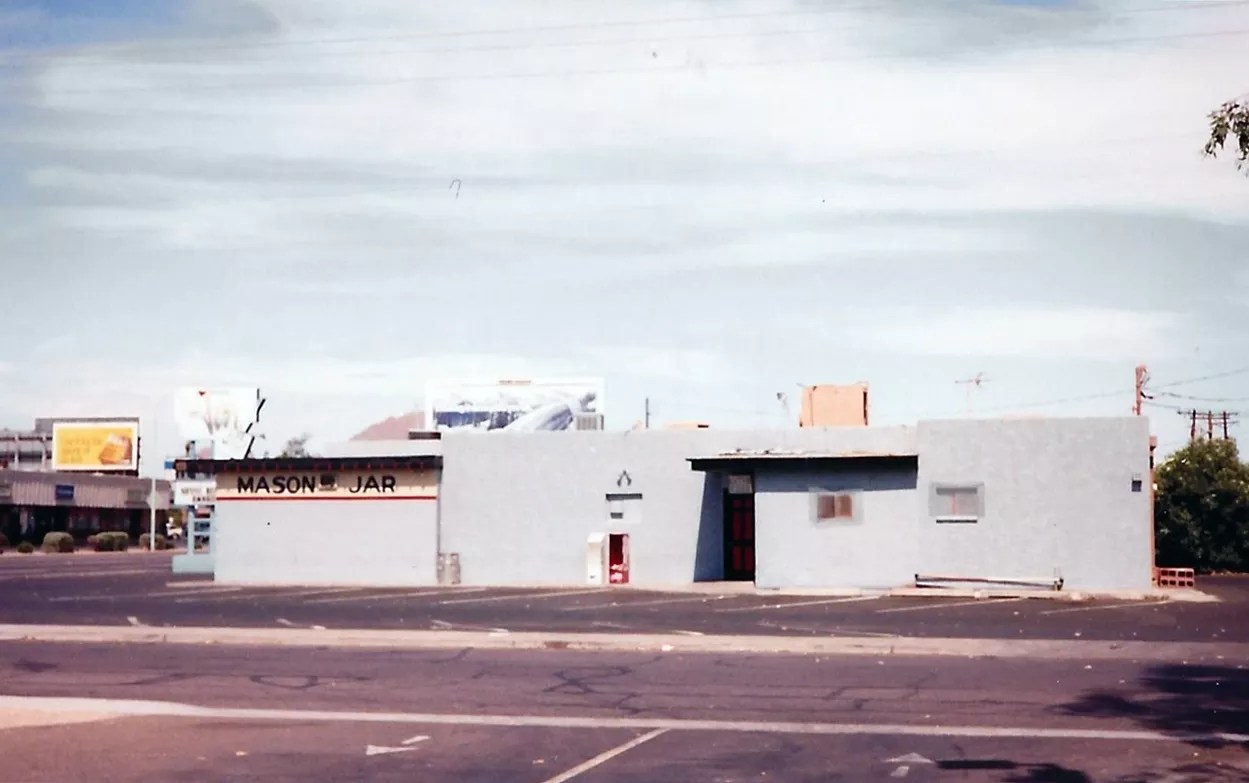
The exterior of the Mason Jar in the early ’90s.
Kevin Bogle
Within the darkened interior of the long, rectangular rock bunker, early Phoenix punk and New Wave acts performed on a stage along one end. Fans peered around inconveniently placed poles for a view or whenever dancing occurred during shows by Phoenix bands such as Blue Shoes and Billy Clone and the Same.
Epic shows were the norm at the Jar, an infamous metal haven in the ’80s. Local acts like Flotsam, Sacred Reich and JFA unleashed an ungodly cacophony. Amps were turned up to 11. Hellacious pits ensued. Faces were melted. Illicit thrills were indulged in.
After Gagliano got dialed in with booking agencies and industry contacts, a stream of up-and-coming artists graced the club’s stage. Red Hot Chili Peppers and Fishbone played their first-ever Phoenix shows in 1985. By the early ’90s, the Jar was hosting gigs by pre-breakthrough acts such as Nirvana, Tool, Pearl Jam, Green Day and Stone Temple Pilots. After Gagliano sold the business in 2000, the club featured future icons such as The Black Keys, Linkin Park, 30 Seconds to Mars and Fall Out Boy before each broke big.
But the Mason Jar was more than a temple for devoted rock fanatics. It showcased thousands of artists and bands, spanning eras and genres: hip-hop, hardcore, ska, rockabilly, synth-pop. It offered refuge to its regulars and a platform for artists who came to drink, perform and lose themselves in the music.
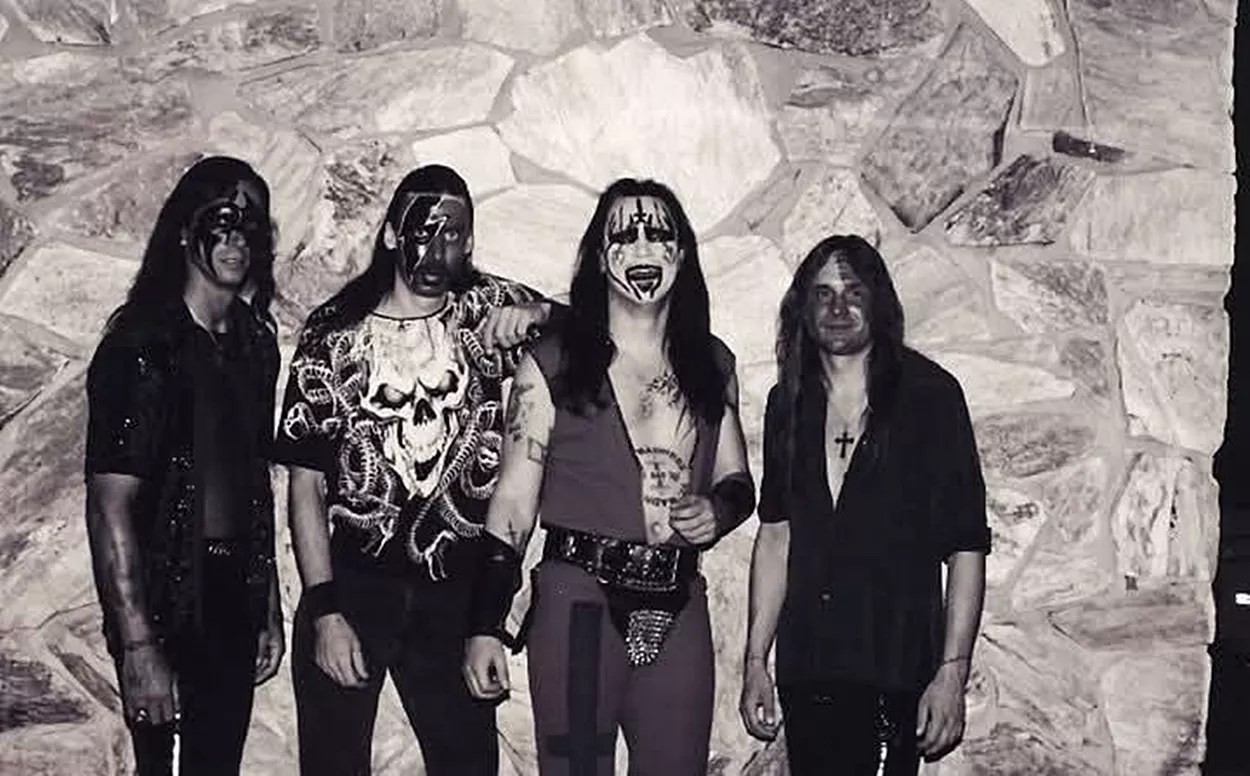
Phoenix metal band St. Madness outside of the Mason Jar in 1998.
Provided by Patrick Flannery
“Everybody played the Mason Jar. It was like our Whisky a Go Go,” says Patrick Flannery, frontman for veteran Phoenix metal act St. Madness. “If you were in a local band and your picture made it on those walls, it was a great honor.”
Last month marked the 20th anniversary of the club’s closing. In May, the Rebel Lounge – which took over the property in 2015 – will mark its 10th birthday with a series of concerts, including performances by Mason Jar regulars Sacred Reich and Authority Zero.
We’re celebrating the Mason Jar’s legacy with the following oral history of the club. While not a definitive chronicle – an nigh-impossible feat given the bar’s run – it’s a snapshot of its impact, its mayhem and the unforgettable moments that made it legendary, as told by the musicians, regulars and others who called it home.

An early ’80s photo of the late Clyde Shields, right, who opened the Mason Jar Lounge in the late ’70s.
John Connolly
Origins of Mason Jar Lounge
In 1978, the late Clyde Shields came to Arizona with dreams of easy cash. His plan? Open a bar.
Michael Shields, Clyde Shields’ son: My father owned a concrete company in Chicago and wanted to move to Arizona and open up a bar. He’d had a friend who owned a bar with a band and (heard) there’s a lot of money in it and it was all cash. And you could do a lot with cash. Lose it, not disclose all of it.
Stephen Chilton, owner, the Rebel Lounge: I know it had been various forms of bars and was the Branding Iron in the ’40s. The line I always use is, “Music has been in that building longer than rock ‘n’ roll has been a thing.”
Shields: Whatever it was, it needed work. Clyde put money into it, dressed it up and cleaned it up.
Peggy Murphy Payne, vocalist and keyboardist for Blue Shoes: The place was kind of classy, kind of dark and had a very nice stage off the dance floor.
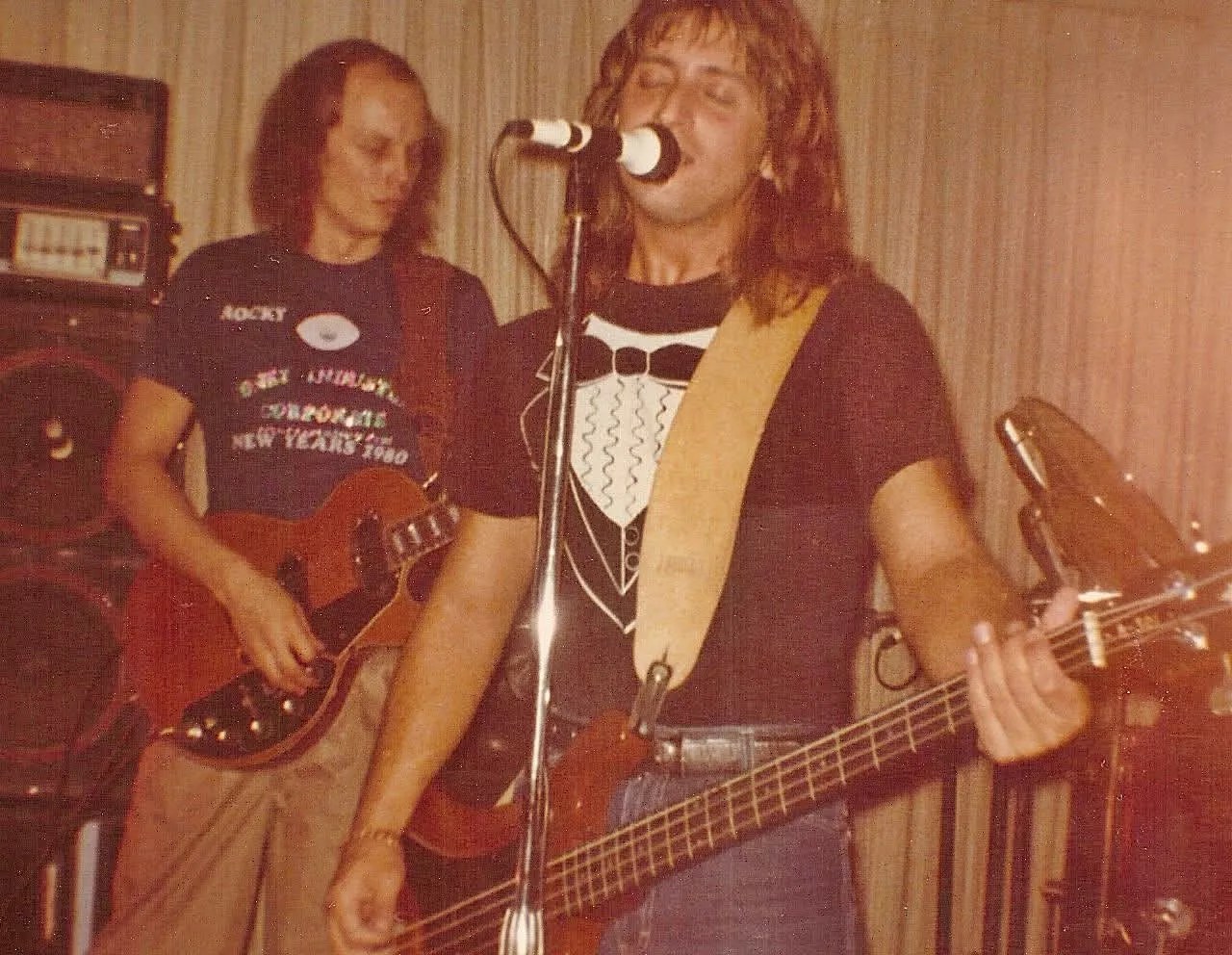
Rocky Hyer, left, and Mark Finizza of ZaZou Pitz during a New Year’s Eve gig by the band at the Mason Jar in 1980.
Provided by Deedee Schwab
Deedee Schwab, former Mason Jar patron: I met Mark (Finizza of Phoenix band ZaZou Pitz) in the fall of ’78 at the Profile Room. I just liked their music a lot and I followed them wherever they went in town. “Oh, you’re at the Mason Jar? Okay, I’ll be there.” It was like our own little Hollywood, all the people who followed all the different bands. And I just went and partied and rocked out whenever they played.
Jack Burke, former Mason Jar patron: I jumped into Mason Jar in the fall of ’79 when Billy Clone and the Same basically had a residence. I’d never seen anything like it. I went in there and it was just swamped. A couple hundred people, all dancing. I was there the one night and then went every night.
Payne: The bands (Clyde) brought in usually played five nights a week. There were times on Mondays if you played there, a lot of other musicians would show up because most musicians had Mondays off. It was known as a place to go for music. It was always a very cool vibe.
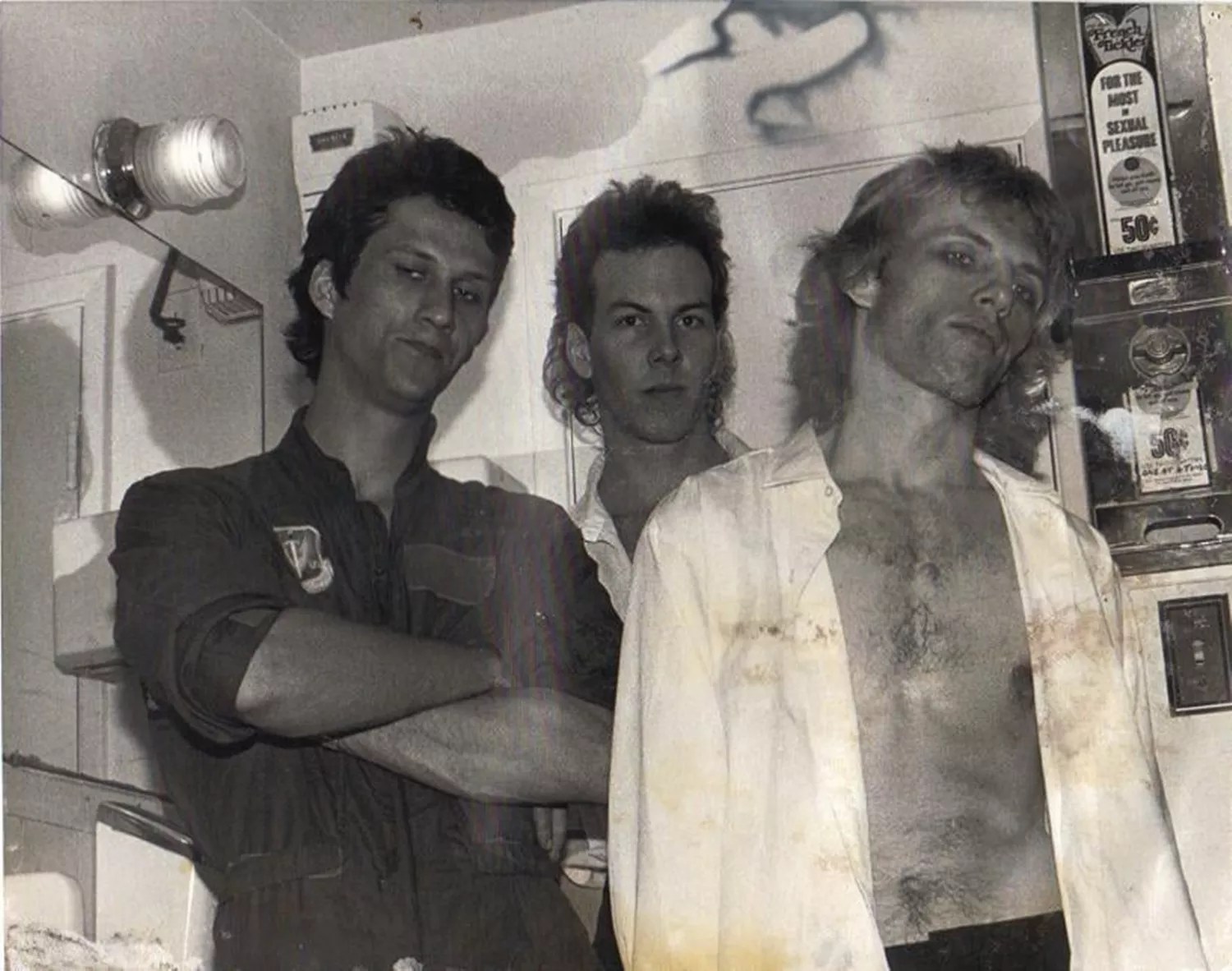
Don Doiron, left, the late Steve Golladay, center, and Glenn DeJongh of late ’70s/early ’80s Phoenix punk act the Spiffs in the Mason Lounge’s bathroom.
Provided by Glenn De Jongh
Glenn DeJongh, frontman and guitarist for the Spiffs and Urge: First time I was in there was in ’79. I’d started the Spiffs and we were playing Lil’ Abner’s in Tempe and drawing big crowds. I called Clyde and he goes, “You’re a Tempe band, I don’t need you.” He always blew me off. So I gave our crowds a piece of paper with his number and said, “Call and ask for the Spiffs.” A week later, he goes, “I don’t know what the fuck you did, but now I gotta book you.” We played there, killed it, line around the building and shit.
Shields: I started working there when I was almost 19. I loved it, because how often does your old man run a very popular bar? I had a lot of good times. A lot of drinking, a lot of drugs, a lot of women, a lot of after-hours parties and I was a young kid.
DeJongh: My band turned into the Urge and when Franco first walked into Mason Jar, it was packed. And so that’s when he decided to buy it.
Franco Gagliano: My cousin was getting married and goes, “Let’s open a restaurant.” We look everywhere with real estate, can’t find anything. So the (agent) goes, “I know this rock bar that the guy wants to sell it.” We go and I say, “Joe, I have fucking no idea what a rock bar is.” We walked in and the place was packed. And I see all those people moshing. At the time, I had a girlfriend back in Rochester, New York. I called her and said, “We’re buying this punk bar.” She fucking freaked out. “Do you know what punks are?” I said, “I don’t know, people dancing. But they bring a lot of money at the register?”
Shields: I don’t know why he sold it, because it was a money maker. Maybe just to get the big cash up front.
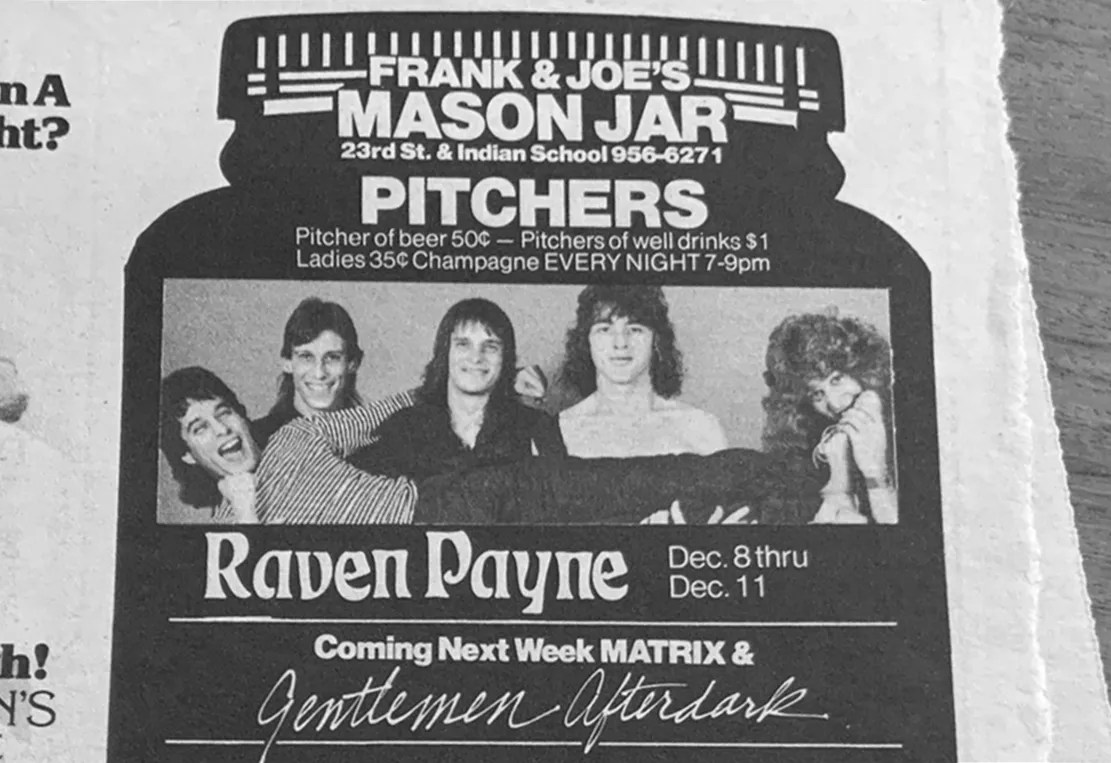
An ad for the Mason Jar from an early ’80s issue of Phoenix New Times.
Deedee Schwab
New owners and sounds
After buying Mason Jar Lounge in in the early ’80s, Gagliano and his late cousin, Joe Tomaselli, made changes. They remodeled the bathrooms, moved the stage and upgraded equipment. They also shook up the club’s bookings, leading to friction.
Payne: We were (booked) there at the time it changed hands. That was kind of a mess. We were booked usually for a week, like a Tuesday through Saturday. It changed, though, after Franco took it over and he fired us.
Gagliano: They played a week when nobody was there. Then I heard about a (metal) band called Raven Payne playing Mr. Lucky’s. So a friend of mine said, “Let’s go over there,” and we check it out. We saw the singer, Jim Seagrave, outside. So I said, “Dude, you guys want to play at the Jar?” He goes, “Well, you got Blue Shoes playing.” I was crazy at the time and I go, “I don’t give a fuck.” So I fired them and they go, “If you’re not going to fulfill our contract, we’re gonna sue your ass off.” I said, “Go ahead and fucking sue me.” I was stupid at the time. I shouldn’t have done that. At least I have big balls enough now to admit when I fuck up.
Payne: He told me that they didn’t want us playing there because we weren’t out in the parking lot doing drugs or playing grab-ass. Right. And I said, “We were hired to play music.” So, yeah, we did sue. We didn’t really see a cent of it.
Gagliano: So I got Raven Payne and the place was packed. Then I used to book them every other month.
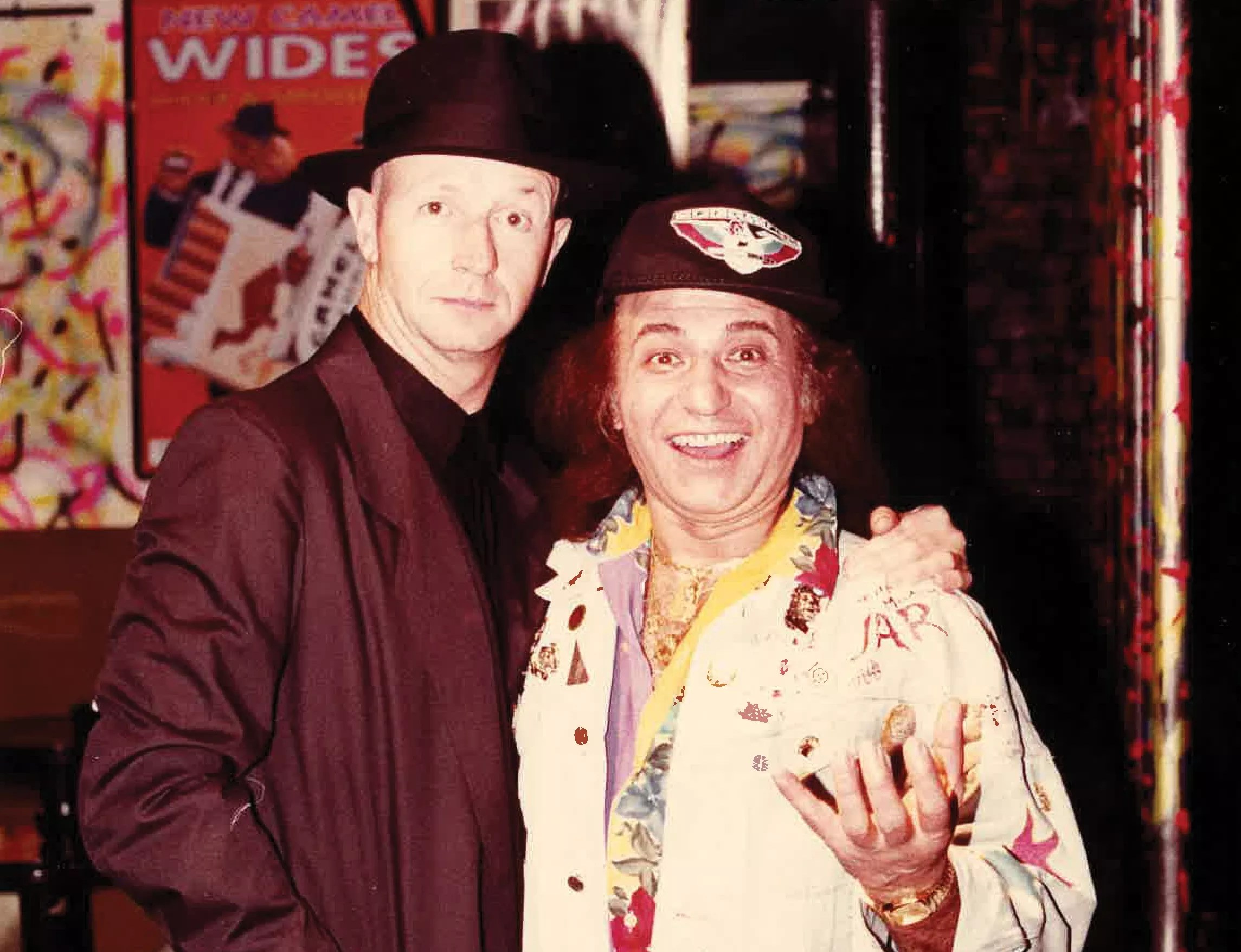
An undated photo of Judas Priest singer Rob Halford, left, with Franco Gagliano.
Provided by Franco Gagliano
DeJongh: The Jar became different. (More) hard rock and metal.
Burke: It kind of changed when Franco took over and basically started turning it into a hole.
Jimmy Keeler, guitarist for Surgical Steel: We’d started playing there and got a big following. We played Rockers and a few other clubs, but Mason Jar was our spot. Everybody showed up. The Dogz, which became Flotsam and Jetsam, would play with us.
Jason Newsted, former bassist for Flotsam and Jetsam: We started playing there in ’82 or ’83. And one of our key (factors) in the early days was once we got comfortable there, we started earning our own following when we started out as Dogz. Then we changed to Flotsam and Jetsam and played the Mason Jar and built a good following on our own.

Flotsam and Jetsam performing at the Mason Jar in the 1980s.
Provided by Michael Gilbert
Keeler: Every week would be pretty wild. The girls back then were great and there was plenty of them and we had a good time. We’d have people come up and jam with us. I remember a few times Rob (Halford) from Judas Priest would come on stage.
Wild times at the Mason Jar were a feature, not a bug. Case in point: what went down in its phone booth or elsewhere.
DeJongh: The Jar used to have a wooden phone booth inside in the front that was known as a place for musicians to get blowjobs.
Gagliano: Around the time we had the Schoolboys, the singer, (Stephen) Clifford, man that guy was such a good-looking motherfucker. He would get in the phone booth all the time. Who knows what the fuck they were doing in there?
Burke: Lots of weird stuff happened behind the dumpster or next to the dumpster. It was kind of a weird hookup spot for a lot of people.
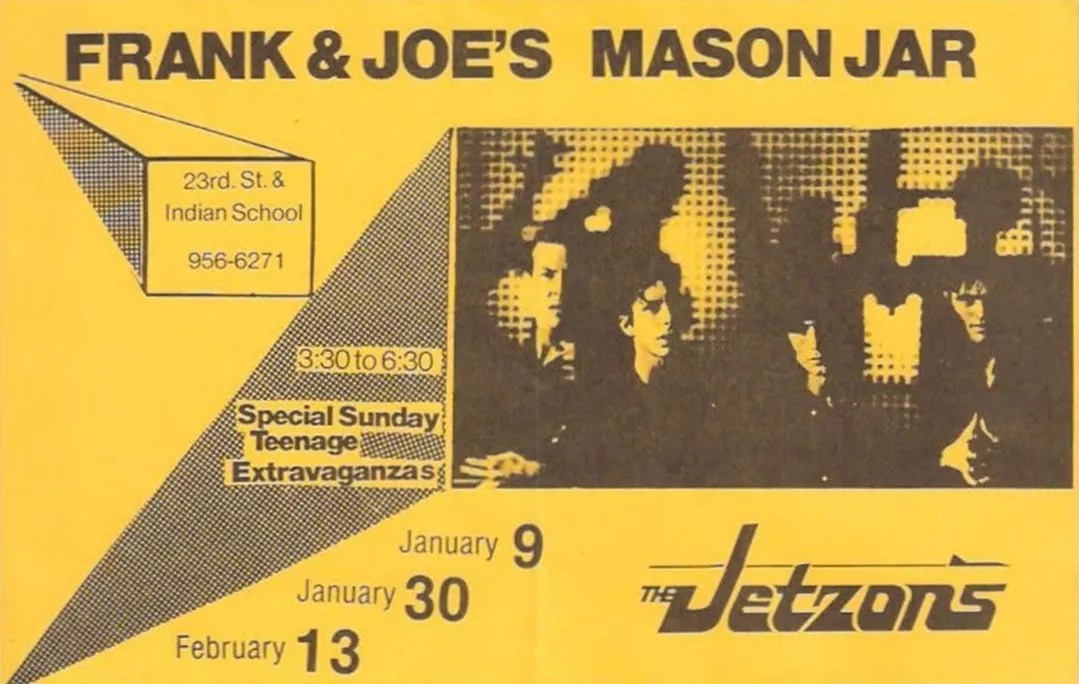
A 1983 flier for a weekly gig by legendary Phoenix band the Jetzons.
Provided by Cait Brennan
While the Mason Jar began to pivot more toward metal under its new owners, the club still brought in local New Wave and post-punk favorites. Some were propelled to bigger things.Gagliano: We used to switch (in) the Pills, the Jetzons, the Psalms. Gentlemen Afterdark came afterwards.
Brian Smith, vocalist, Gentlemen Afterdark (in 2000): I first met Gagliano when I was a teenager playing in my first real band. We were playing at a Tempe club called Merlin’s – or maybe it was still called the Star System, I don’t recall. Franco was there scouting bands for his just-purchased Phoenix club, the Mason Jar Lounge. He handed me a business card and invited our band over for after-hours.
DeJongh: The Schoolboys went from playing the Mason Jar to getting a record deal on Capitol, being produced by Eddie Kramer, who worked with KISS. They had to change their name to ICON. People went from the Jar straight into that. It was a stepping stone out.
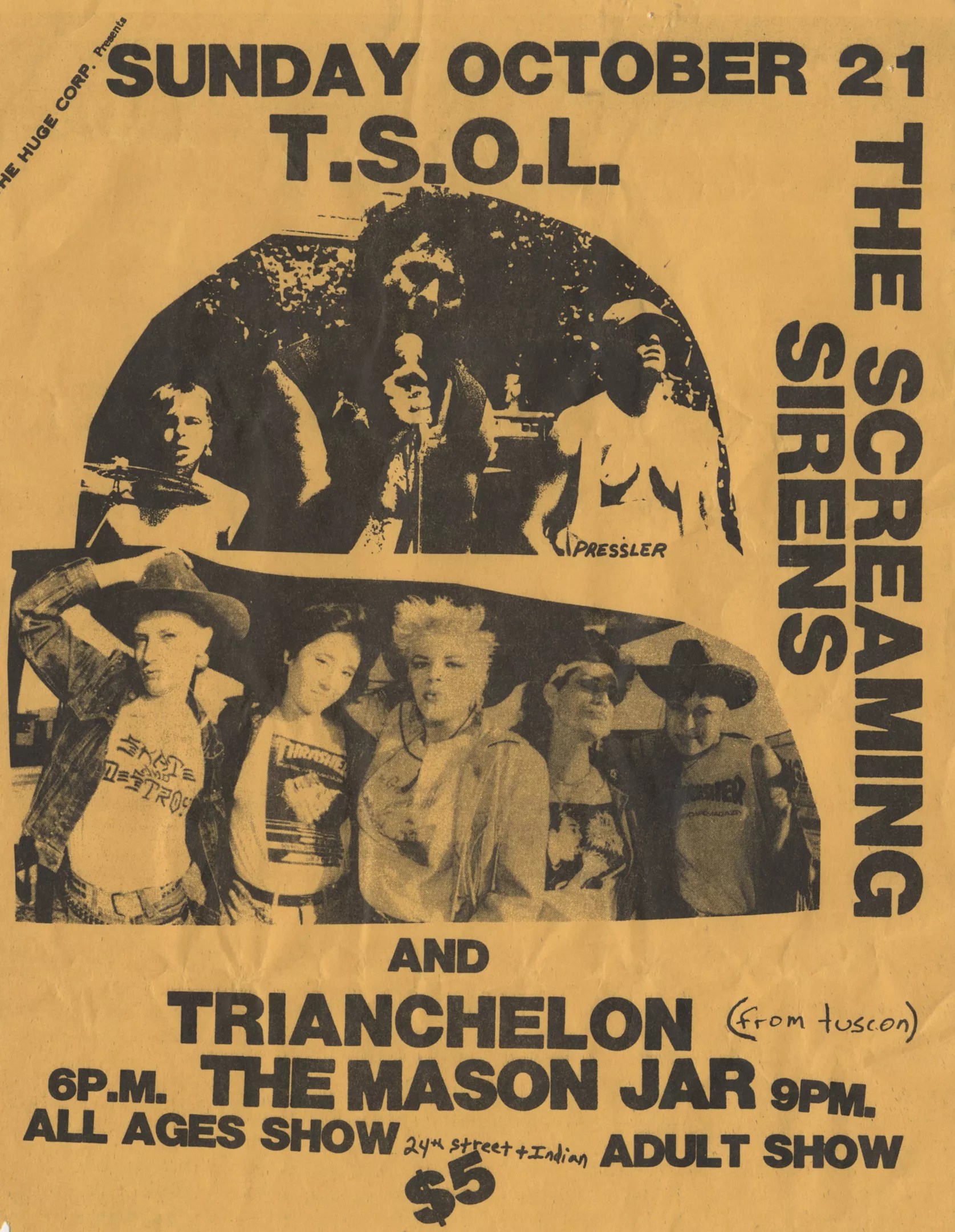
A 1984 flier for a TSOL gig at the Mason Jar.
Tempe History Museum
In the early-to-mid ’80s, the Mason Jar began hosting all-ages matinee shows, a rarity among Phoenix rock clubs.
Patrick Flannery, vocalist for St. Madness: There were lines going all the way around the building and down the street of kids who couldn’t wait to go to those matinee shows.
Michael Pistrui, vocalist for Beats the Hell Out of Me: There was a small group of kids that were regulars at those shows. As a high school kid, the Mason Jar was a really cool place. And I was in Chandler, so it wasn’t an easy task to get there if you didn’t have your own car. We’d all pile in with somebody to go to these shows.
Michael Gilbert, guitarist for Flotsam and Jetsam: When I was 14 or 15, I started going for the all-ages show. My parents drop me off with my friends. The very first time I ever saw Flotsam and Jetsam before I joined was at the Mason Jar and I was like, “Man, I want to be in that band.”
Cathie Mancini, former Mason Jar patron: GBH was one cool show I remember. I was 16 and (snuck) in my Jack Daniel’s in airplane bottles.
Moshing was common at Mason Jar’s all-ages punk shows and anyone in the pit had to watch out for the floor-to-ceiling poles in the middle of the dance floor.
Tom Reardon, bassist, Hillbilly Devilspeak: There was always an obstructed view of the stage. You were constantly having to be aware of (the poles) and try going around while you’re getting pushed. The pole closest to the stage was definitely responsible for me spilling blood on more than one occasion.
Tragedy struck Gagliano in 1984 when his cousin, business partner and Mason Jar co-owner died from cancer.
Gagliano: He was my right-hand man. If it wasn’t for him, I never would’ve bought the place.
Gagliano sought bigger acts. He linked up with high-profile booker Frontier Booking International and attended the New Music Seminar in New York City.
Gagliano: We go to a party they had for FBI. That’s where I met Fishbone and Red Hot Chili Peppers. Nobody knew who they were. So I introduced myself and said, “Anytime you guys want to come (to Phoenix), I’ll take care of you. I get your backline, food, beverage, whatever.” Schmoozing paid off. Both bands made their Phoenix debut at the Mason Jar in June 1985. Other touring acts followed. For the rest of the ’80s, Mason Jar thrived as metal’s popularity soared.
Keeler: Metal was really strong back from ’82, ’83 all the way up to the ’90s. Everybody that was somebody would go there. Franco would book some good bands.
Reardon: Metal was Franco’s bread and butter.
Gagliano: Alice Cooper, he left his boot there one night. And then I said, Alice, you left your shoes over there, man. He goes, “No, I didn’t.” I said, “Right here. You might as well autograph the motherfucker,” so he autographed it. He would drink through a bottle of Bacardi. Every night he was there.
By the late ’80s, legendary Phoenix concert promoter Danny Zelisko was booking shows regularly at the Mason Jar through his now-defunct company Evening Star Presents.
Danny Zelisko, Phoenix concert promoter: For me, the thing that set The Mason Jar apart from other similar-sized clubs of that size was I’d established a relationship with Franco and it was a good one. We got along and shows happened, came and went without too much drama. If you’ve got a tough venue with a guy that doesn’t know how to operate or gives you a hard time, which happens, you can have disasters in a 200-seat place. We didn’t usually have that with Mason Jar. I do remember a whole lot of fun.
One of the Mason Jar’s claims to fame was the string of future legends who rolled through starting in the early ’90s: Nirvana, Tool, Rage Against the Machine, No Doubt, Green Day, Melvins.Zelisko: He had a great run of events, and a lot of those groups would’ve ended up playing for him anyway, because they’re all new groups and they’re hungry and they need a place to play.
Reardon: I think everyone’s seen that (YouTube) video of Nirvana at The Jar in 1990.
Gagliano: (Krist Novoselic) had a broken leg at the time onstage. And they were fucking around and he broke a glass, because at the time we used jars. So you might see me (in the video) with a little sweeper sweeping the glass out.
Buzz Osborne, guitarist and vocalist, Melvins: I remember one of the first shows we played there, I got propositioned by this bondage chick who wanted to take me home to her dungeon and I bowed out. I’ve watched too many serial killer movies, you know?
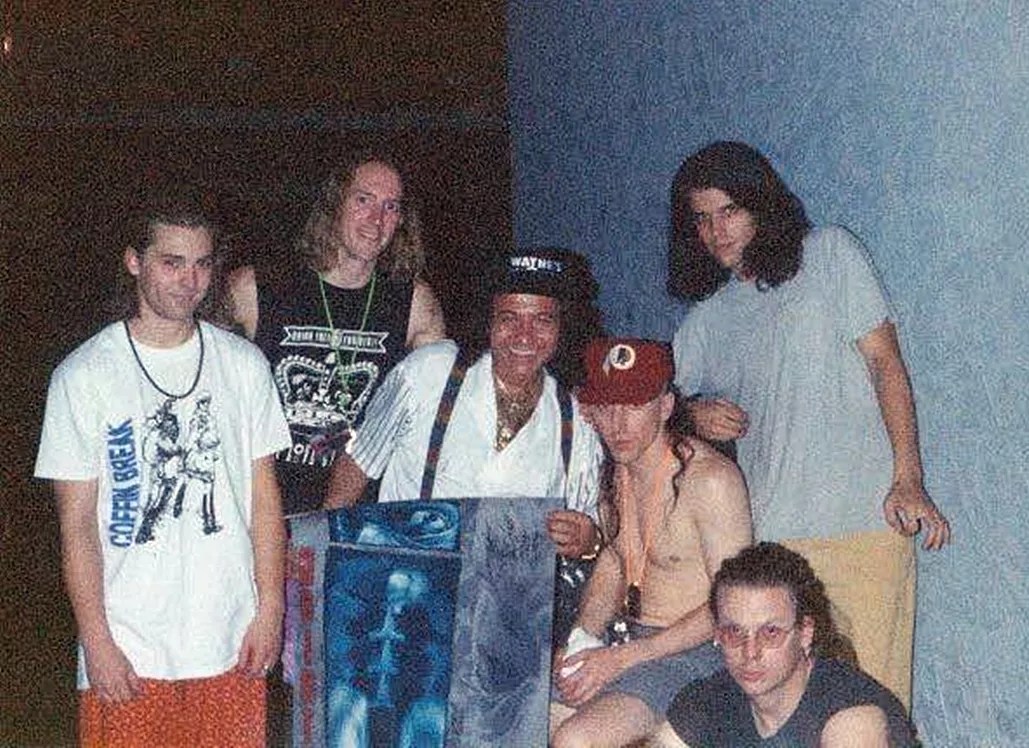
The members of Tool in 1992 outside of the Mason Jar in Phoenix with the venue’s then-owner Franco Gagliano (center).
Provided by Franco Gagliano
Tool’s summer 1992 Phoenix gigs happened thanks to Gagliano’s ties with John Branigan, the band’s longtime agent. After partying together in L.A. in late 1991, including seeing Tool at their loft, Branigan booked the band at the Jar.
Gagliano: He told me, “Franco, remember the band we were partying with? I think they’re going to be real big.”
Anthony Savastano, Gilbert resident: The Mason Jar was a killer place. It was small but personable. Seeing Maynard (James Keenan) scream at like 20 or 30 people made it interesting. It was an intimate, crazy gig.
Kevin Bogle, former Valley resident: I just remember being up at the front on the side of the stage and watching Maynard. He had a Mohawk back then, which was sweaty (and stuck) all over the sides of his head. He was hunched down and crouched down during the show, looking like this weird animal. I’d never seen Tool before, but they were pretty wild.
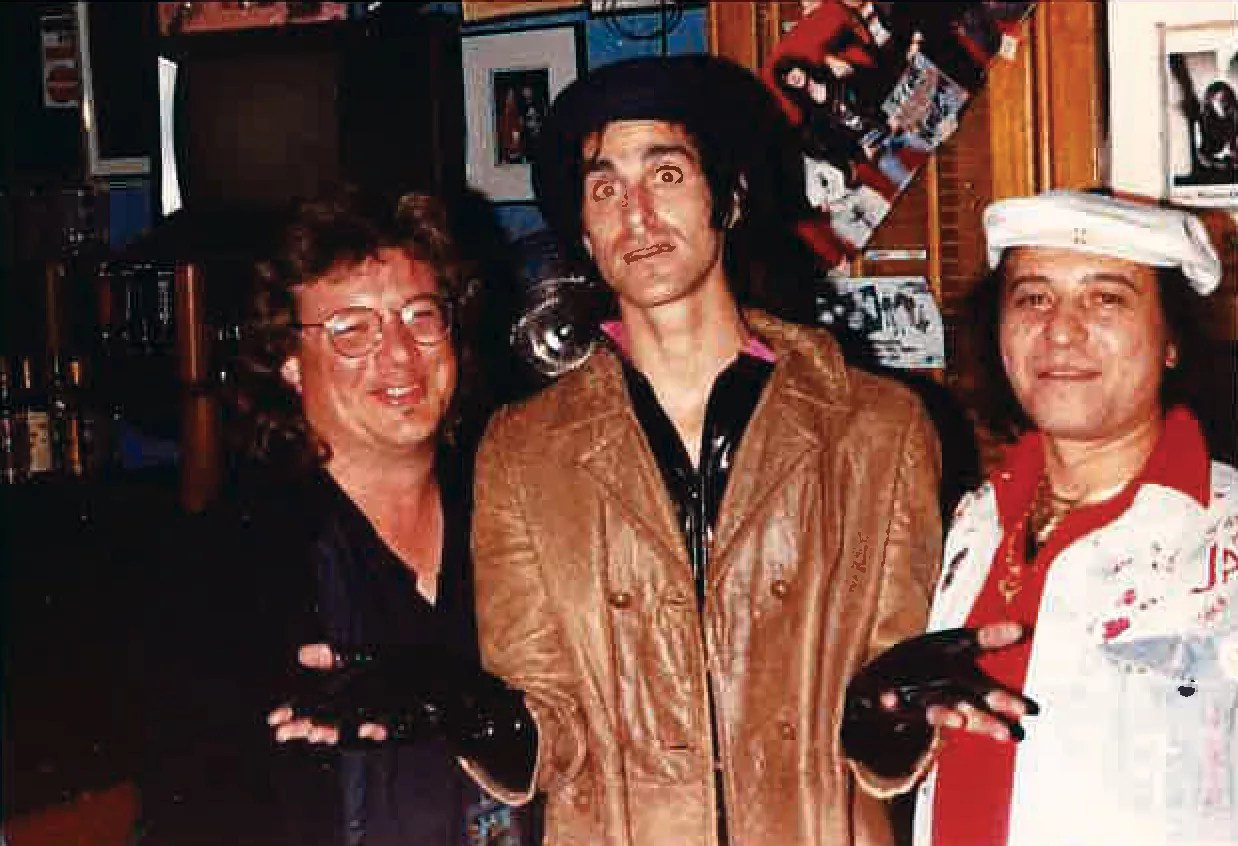
Perry Farrell, center, with Franco Gagliano, right, and Phoenix concert promoter Danny Zelisko at the Mason Jar.
Provided by Franco Gagliano
The ’90s were a busy time for the Mason Jar. Every night was booked with local and touring artists from multiple genres. Jangle-pop acts from Tempe. Goth and industrial groups. Up-and-coming rock and metal bands.
Sean Dowdell, drummer for Grey Daze: The very first show we ever did was an all-ages at 5 o’clock on a Saturday in ’92/’93. It was Chester (Bennington’s) first show he ever played.
Flannery: If you played the Jar, it wasn’t just any other stage. It was special. And I’ll bet I played there 75 to 100 times over the years. It was an honor.
Former Mason Jar patrons vividly recall ’90s shows, some of which got messy.
Jeremy Kinison, performer with Cut-Throat Freak Show: Back when I was a prank monkey for Meatwhistle, I brought 20 cream pies. Every time a band member fell down they’d get hit with a pie in the face. The stage kept getting more and more slippery. It was a dang ruckus. And they still managed to play a really good set.
Rance Granthrax Jorgensen, performer with Agents of Lust: The Genitorturers show with the rack spinning and then an enema getting spayed all over the audience. Good times.
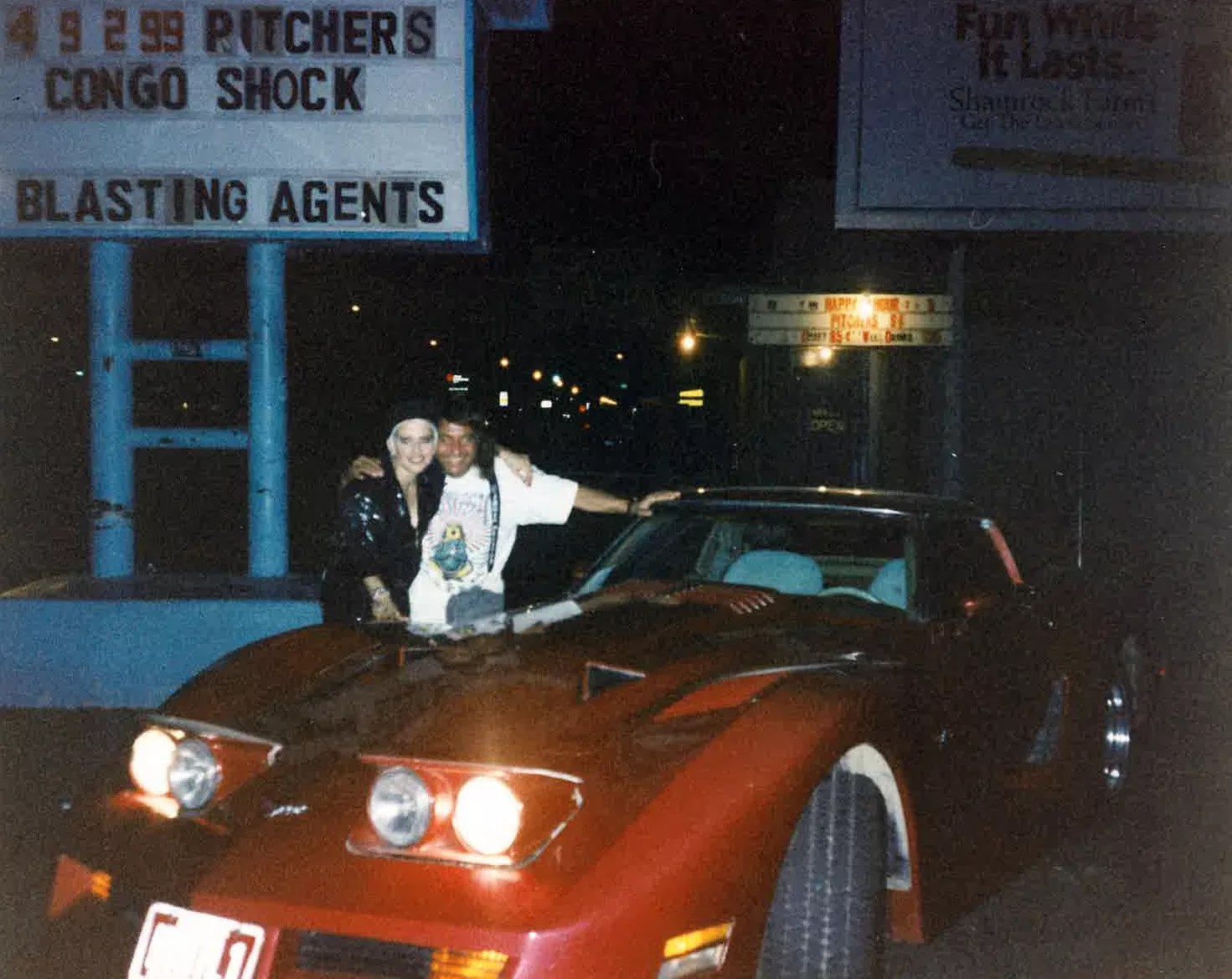
Franco Gagliano, right, outside the Mason Jar with the 1977 Corvette he purchased from Judas Priest frontman Rob Halford.
Provided by Franco Gagliano
Gagliano was notorious for stingy payouts. Novoselic even called him out at Nirvana’s 1993 Arizona State Fair show for charging the band for mic rentals years earlier.
Gagliano: I’d say, “Hey, you know what, if you bring people, I’ll pay you so much. If you don’t, I remember.” If you have three people and say you’re going to bring 100 people, don’t expect me to pay for 100 people. And they go, “You fuck us. You fuck us.” No, I didn’t. I’ll pay you if you bring people.
Smith (in 2000): For those bands labeling Franco a thief, consider this: His payout theory was always the most proven and correct one, the one used in cities like Philadelphia, New York and Los Angeles. If bands draw a crowd, bands make money. Simple. You just had to trust him on this.
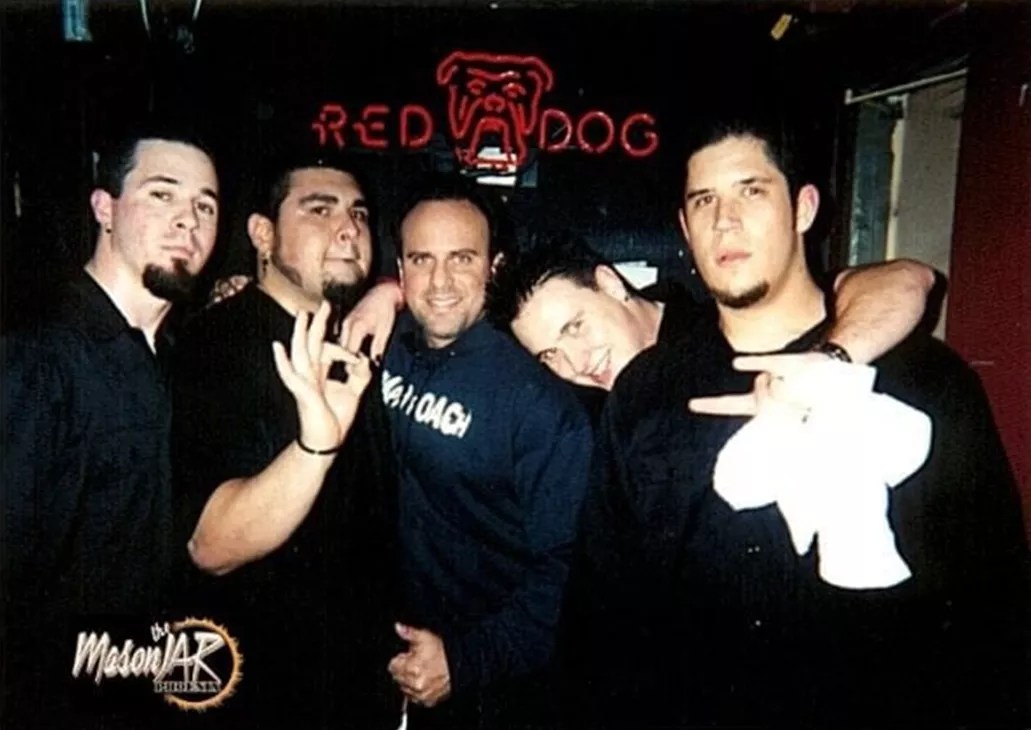
The members of Papa Roach with Mason Jar owner Michael Manfredi in 2000.
Provided by Michael Manfredi
The turbulent 2000s
In early 2000, Gagliano sold the Mason Jar business again, this time to Phoenix stockbrokers Michael Manfredi and Gary Steiner. For Gagliano, it was a divine mandate.
Gagliano: God said, “Franco, you need to go to next direction.” I didn’t want to do it, up to the last minute. I was two hours late to sign it (over).
Michael Manfredi, owner of the Mason Jar (2000 to 2005): I think Franco wanted to retire. He’d had (the Mason Jar) for 20 years and sold it a couple of times and it never stuck.
Gagliano: Michael and his partner, Gary, made a lot of money on stocks and wanted to come in. I said, “I’m giving you guys this fucking gold mine here.”
Manfredi: Honestly, the place needed a lot of upgrading. The beer was warm. The sound system wasn’t great, even though Franco thought it was the greatest.
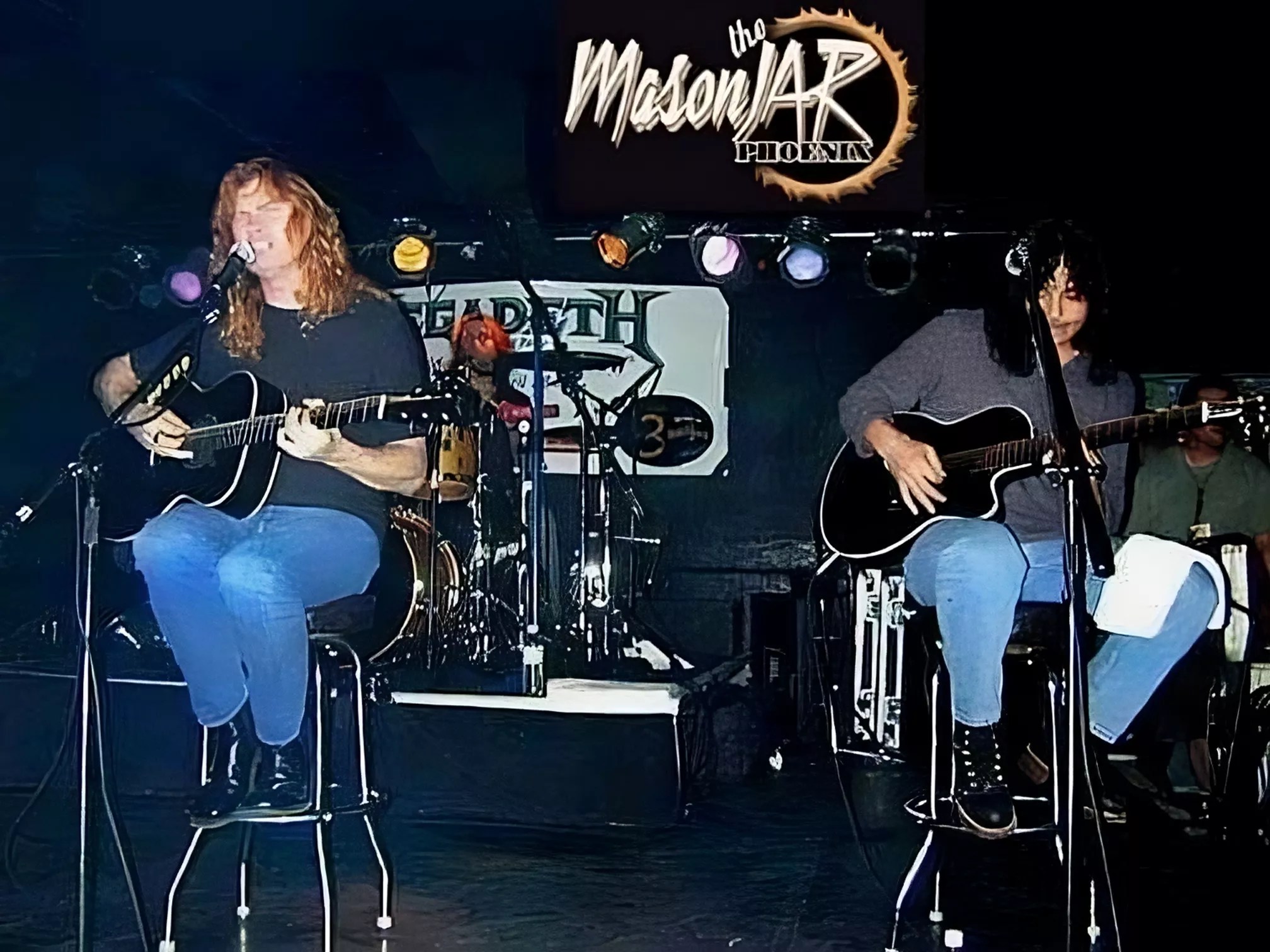
Megadeth performing at the Mason Jar in 2001.
Provided by Michael Manfredi
The club’s condition and issues between Manfredi and Steiner led the pair to sell the Mason Jar less than a year later to then-promoter Tom Gaffney and others behind the short-lived venue Web Theatre in downtown Phoenix. The club returned to Manfredi’s possession by 2001. He started over from scratch, promoting local bands. He also got help from powerhouse Phoenix rock station KUPD.
Manfredi: KUPD brought us Megadeth and we didn’t even have to sell tickets. You had to call the station. It was kind of like an “(MTV) Unplugged” thing with tables and candles and it was a really big show. It put us back on the map.
Kevin Vaughan-Brubaker, former Mason Jar patron: My band, The Haystacks, played there in 2004. I was playing bass and decided to jump in the air. My left knee blew out and I crumpled to the stage but kept playing. I finished our set sitting on a chair. Two knee surgeries later, my barking knee reminds me of the Mason Jar.
Stephen Chilton, as Psyko Steve Presents, had been promoting indie shows locally and was looking to expand.
Chilton: I was doing small DIY stuff around town and then sort of elevated things after going, “Hey, here’s more of a venue.” I did a lot of great shows there for a couple of years at the Mason Jar. I booked an Avenge Sevenfold with Atreyu there, booked American Nightmare there.
Manfredi: We got a good sound system and I got big touring bands to come in, some really big bands that went on to sell arenas. We did shows with Linkin Park and Papa Roach. Yeah, that’s right. In 2002, ’03 and ’04, our last three years in business, we averaged 30, 35 shows a month. We were number one on Ticketmaster.com. We set all kinds of new records for attendance and for liquor sales.
The Mason Jar’s success makes the bar’s abrupt closure on Feb. 15, 2005, a mystery. At the time, New Times reported a “rumored standoff” with Gagliano. But Manfredi says he simply chose to walk away. He sold the business and liquor license to Lynn Johnson, owner of defunct Camelback Road LGBTQ bar Harley’s Club 155.
Manfredi: Honestly, I got married, had a baby. And the music was changing. It was starting to become really heavy into hip-hop. We did some hip-hop shows – Ice-T, Wu-Tang Clan … there were a whole bunch of ’em, but it wasn’t our thing. We had some hip-hop promoters that did those shows, but our thing was rock ‘n’ roll and we were kind of getting too far away from it.
Gagliano: I think it was too much for him. And then this lady, Lynn Johnson, (offered) him $200,000 just for the business and license. It was crazy.
In 2006, the property became LGBTQ dance club Velocity 2303. In 2011, it became Anvil, a leather bar.
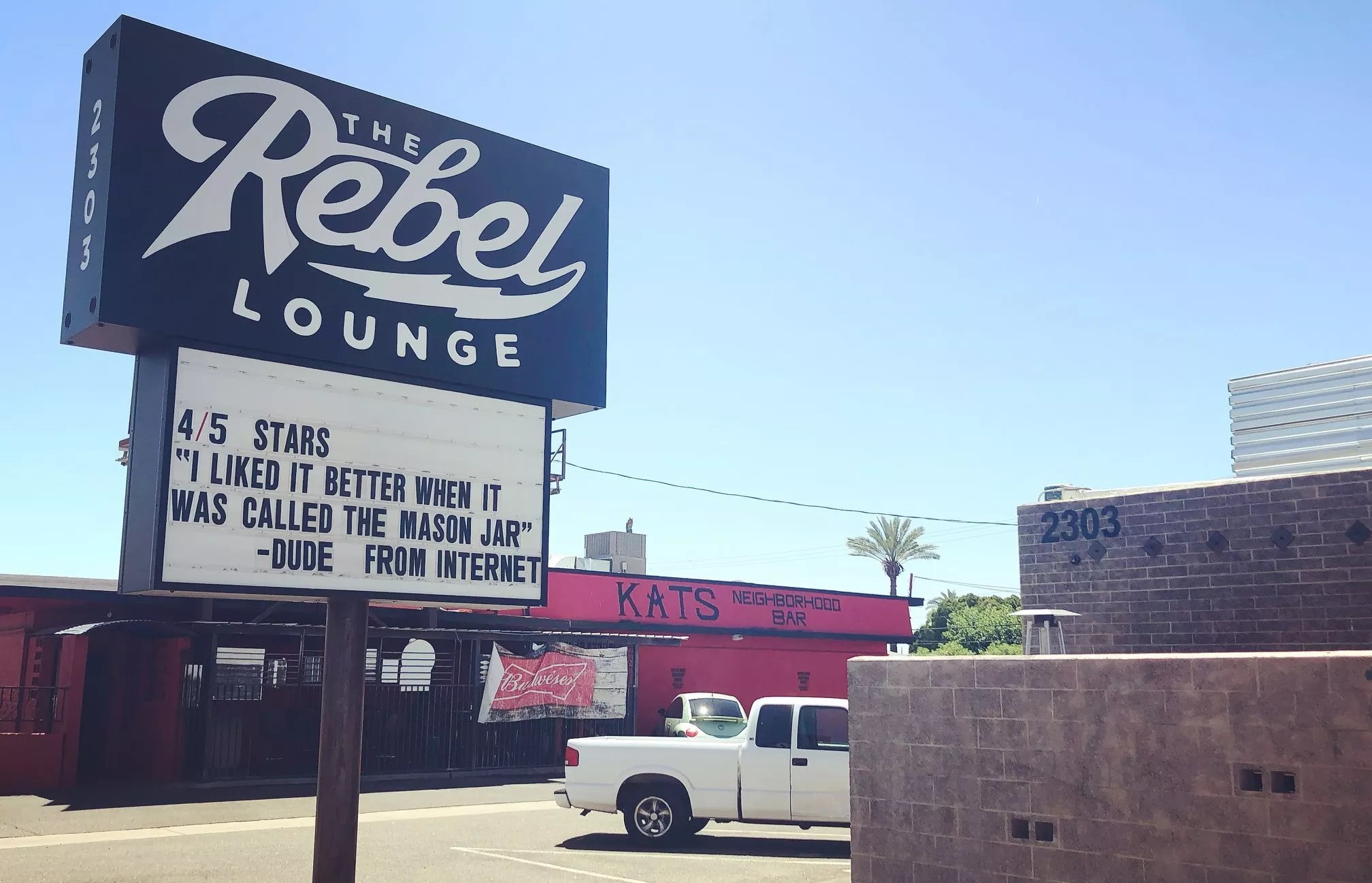
The Rebel Lounge has both embraced — and skewered — its property’s history as the Mason Jar.
The Rebel Lounge
The rise of the Rebel Lounge
In 2014, Gagliano put the Mason Jar property on the market after Anvil relocated. Enter Chilton and local developer Chuckie Duff, who purchased the building, gave it a renovation and opened the Rebel Lounge the following spring.
Chilton: Chuckie called me about it being up for sale and said, “We should do this,” knowing I’d booked many shows there and the history of the building was something we wanted to preserve and tap into.
Dowdell: The Rebel Lounge has a nostalgia factor for going for it, like with the Whisky (a Go Go) in L.A. The Whisky’s a bigger venue, but when you play there, it has that provenance. When you walk in the door, you’ll be on the stage where Jim Morrison played. So this place, albeit smaller, has a lot of history for Arizonans and people who grew up in Phoenix.
Chilton says the Rebel Lounge has embraced the property’s history over the past decade – including selling “Yes, we know this used to be the Mason Jar” beer koozies – while forging its own identity.
Chilton: When we took it over, I was clear it was going to be a new thing. It was never going to be what the Mason Jar was. That moment was an era and that’s gone. We wanted to distinguish between what we are, but also that the history is there. It’s real.